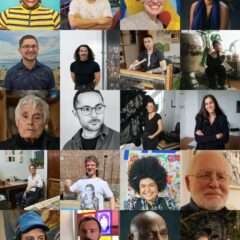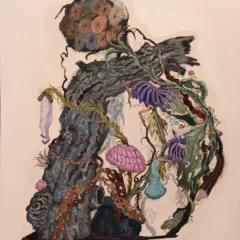[This is part 1 of a two part story.]
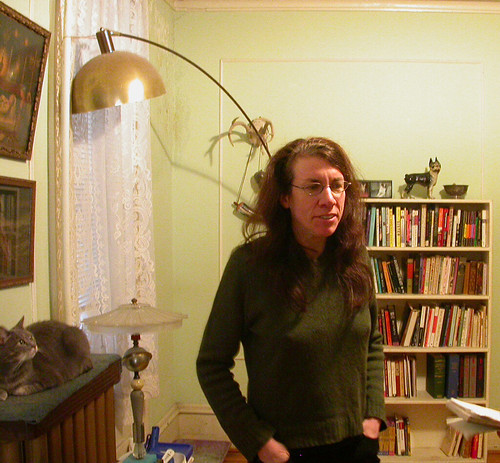
Judith Schaechter with one of her five cats in her South Philly house.
We had lunch with one of contemporary art’s heavy hitters the other day and she made us quiche. Judith Schaechter had just come home from a driving lesson during which her driving instructor was pumping her for information about how to be an artist while she was on Delaware Avenue trying to remember how to brake and steer. Meanwhile, back at home, she tossed the lunch on the table as if it was nothing and started talking. Two and a half hours later she was still chatting about art, life, cats, Scotland and the computer.

Judith’s Joan of Arc, a stained glass piece featured in her recent Claire Oliver show.
Schaechter, feisty as a bantam weight, is funny and charming. Her solo show of new stained glass light boxes at Claire Oliver Gallery just ended. The works sell for 6 figures and when we saw the show Nov. 3, three were sold. The nationally renowned Pew fellow whose art has even appeared on the cover of the New Yorker (1993, cover illustration for Sylvia Plath article, August 23-30) is also a writer. She used to write book reviews for Philadelphia Weekly and she was one of the first contributors to artblog. Every once in awhile — because she’s so passionate about her work, and ideas about art — she gets embroiled in a comment conversation on artblog that goes on for days. She apparently does this on other websites and message boards as well.
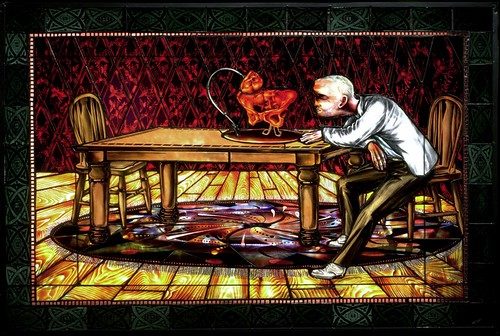
Her house with its five cats and weird specimens including taxidermy wonders, skeletal remains and bugs and butterflies in glass cases on the wall is neat as a pin and completely organized. So is her studio.
We’ve enjoyed Schaechter’s stained glass since the first time we saw it. While she works in one of the most ancient of media, stained glass, dripping with religious symbolism, her art is completely contemporary, speaking about modern life, relationships, predicaments but also saintly sufferings. Her focus is on the human and not the religious and that has made her controversial in some circles. But she’s not controversial in ours. We love her work to death. She’s Saint Judith.
And now she’s doing animations, too. More on that later.
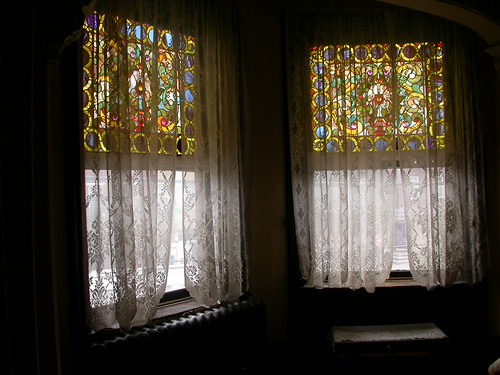
Stained glass windows in Schaechter’s Victorian-era house.
We took a tour of the house, a South Philly rowhouse with drop-dead stained glass of its own. The house itself yielded up a number of stories from her. Here below are some tidbits from our rambling conversation which was in many parts a monologue by Judith.
For a bit she discussed her relationships with galleries.
Re Claire Oliver, her current gallerist, in New York:
Schaechter once complained in frustration to Claire over the phone before a big opening that “My hair won’t work!” They were in a hotel and Claire “came down in her slippers, did my hair, and it looked great.”
Re her previous gallerist, Rick Snyderman, in Philadelphia:
“I really like Rick Snyderman. He did great things for me, but I don’t think I owe my entire career to him.”
But switching to New York had its downside. Openings at Snyderman were the best openings, she said. “It’s much better to show in your home town than in New York. It was like a big prom for me.”
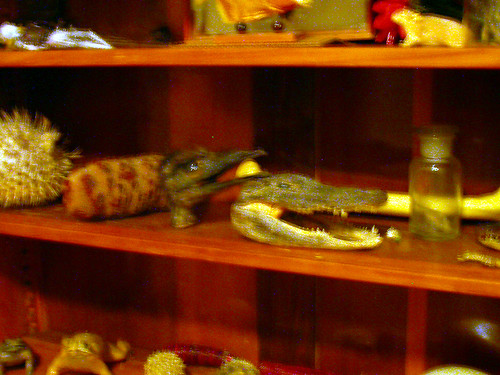
Cabinet of curiosities. Judith’s emu head, second shelf.
She showed us a bunch of specimens, including a critter that seemed more imaginitive than real, from Furry Couch. “He had a fanzine. Now he’s at Tattoo Eddies and sells taxidermy.”
She picked up an emu head from a bookcase filled with strange things.
“I did buy that, I bought the emu head. I feel a little guilty about it. …People just give me this stuff!”
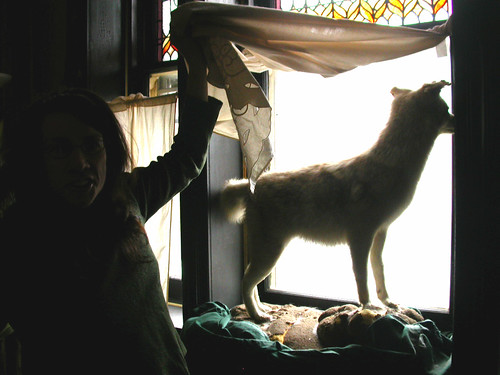
Judith pulling back the curtain, ala Charles Wilson Peale, to show us her stuffed coyote in the front window.
Then we walked to the front window, where a dog-like stuffed animal stands perched on a promontory overlooking the street. It reminded us of the way the Remington horse overlooks Kelly Drive. One of us called it a coyote, could have been Judith, could have been us. we wondered, Does it keep people away?
“I think it keeps people from asking too many questions.”
As we walked through the house, we asked Schaechter to tell us which museums collected her work. Here’s an an abbreviated list:
Philadelphia Museum of Art has two, both stained glass
Carnegie–“They have the best one I ever did, and they have it in storage.” (said with a touch of frustration)
Metropolitan Museum of Art, in its contemporary collection

Schaechter’s collection sprawls through every room of the house. Here, above the fireplace in the living room, is a painting by her grandmother, a Rain Harris poison pot, and three specimens, a butterly, a bat, and a spider — and some glass pieces whose authorship we don’t remember.
She also showed off her own, eclectic art collection. Here’s another edited list:
Chris Vecchio
Olivia Shreiner–“I saw it in artblog and went and bought it.”
Astrid Bowlby
Ben Woodward
C.W. Wells
Rain Harris
paintings by her grandmother
her mother‘s hippo collection including a hippo Judith herself made, maybe in first grade. “My first sculpture was a hippo for her collection.”
And here are the names of her cats, while we’re naming names.
Rain (Laraine)
Chong
Tyrone
Siouxsie (after Siouxie Sioux in Siouxsie and the Banshees)
Spock (with a deformed ear, natch)
Before she moved to 11th Street from 15th and Rodman, Judith had a trinity and a separate studio down the street, above the space that is now Bob and Barbara’s. The studio there was bigger, “This is smaller but has windows. …I don’t like clutter.”
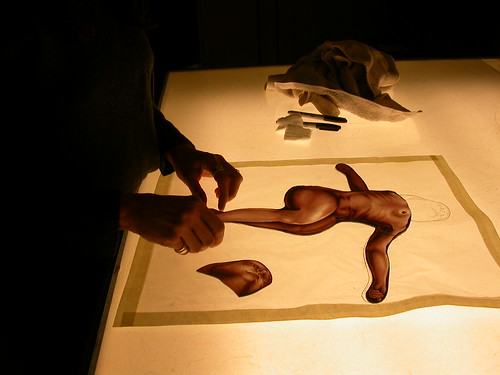
Schaechter, assembling the pieces of her current glass project.
She showed us her current stained glass project, a figure resting on sea of grass, looking up at the sky, inspired by a visit to a wind farm in Scotland over the summer, where Schaechter lay on her back under a giant windmill. “It’s not working,” Schaechter opined about the stained glass figure for her image. “She looks segmented–like a turd.”
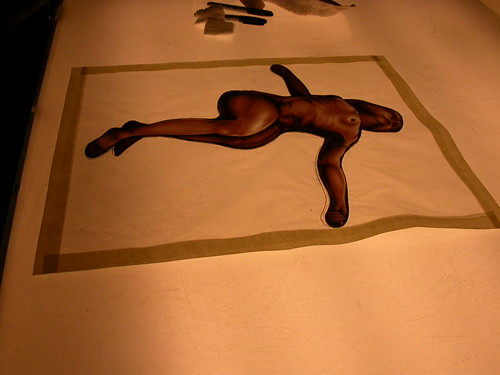
Schaechter’s current work in progress sitting on the light table in her studio.
Then she fetched some other rejected work. “There’s boxes of things I’ve thrown out.” She showed us a broken bit that had a u-shaped chunk chipped off during shipping from Scotland. “What did they do, did they take a bite?”
We asked how she assembled her stained glass.
She uses copper tape on the edges. She layers. She cuts the glass with a jig saw. And she assembles with a bead of solder (a mix of lead and tin).
“I love lead.”
We wondered about the toxicity, but Schaechter has her levels tested. “My lead levels are lower than average. I’m thinking you have to snort lines to get lead poisoning.”
She did once get glass in her eye–and said she put her fingers in her eye and pulled the glass out. Now she wears safety goggles.
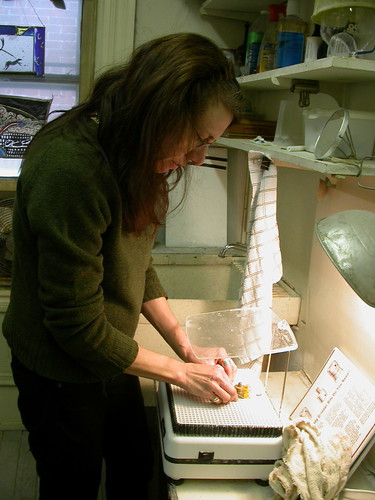
Schaechter, demonstrating how to grind glass in her tool-filled, tidy studio.
Then we admired her grinder (she put her finger to the spinning grindstone to show us how safe it was), her ring saw and her glass fusing kiln. The light boxes for the finished works are built by Kevin Strickland.
She then began to talk about the house with its voluptuous stained glass. “They are the opposite of ecclesiastic works,” she said. “The story is, the house was built for some guy’s mistress.” When Schaechter moved in, she had local stained-glass artisan and artist Bryan Willette restore the glass.
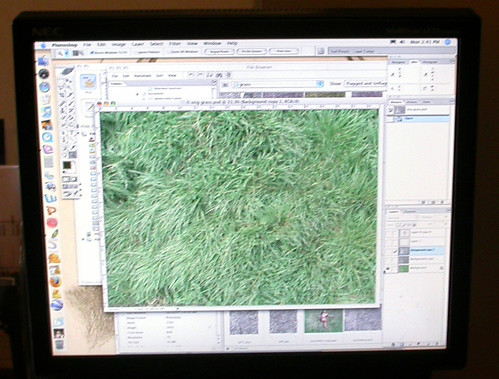
Grass pattern from Mayang website that was the basis for Schaechter’s grass background in a new print.
Schaechter took us over to her computer to show us her drawings and a website–Mayang’s Free Texture Library–with free patterns from which she got the grass that she altered to use in a new print she’s making with Silicon.
Astrid [Bowlby, who makes labor-intensive drawings and who Schaechter calls her bff, best fried for life] came over. I was showing her Photoshop. ‘So it’s not really a time saver, is it?’ said Bowlby. ‘It’s a time waster.'”
For all that, Schaechter loves the computer, especially Photoshop. We spent a good half hour at the computer, while she showed us how she transformed the grass pattern and how her figures get assembled. “I just put my doodles into Photoshop and then start collaging,” she said, while mixing and matching heads and bodies for us.
Read Part 2 of this story. And for more pictures from our studio visit, see this flickr set.


